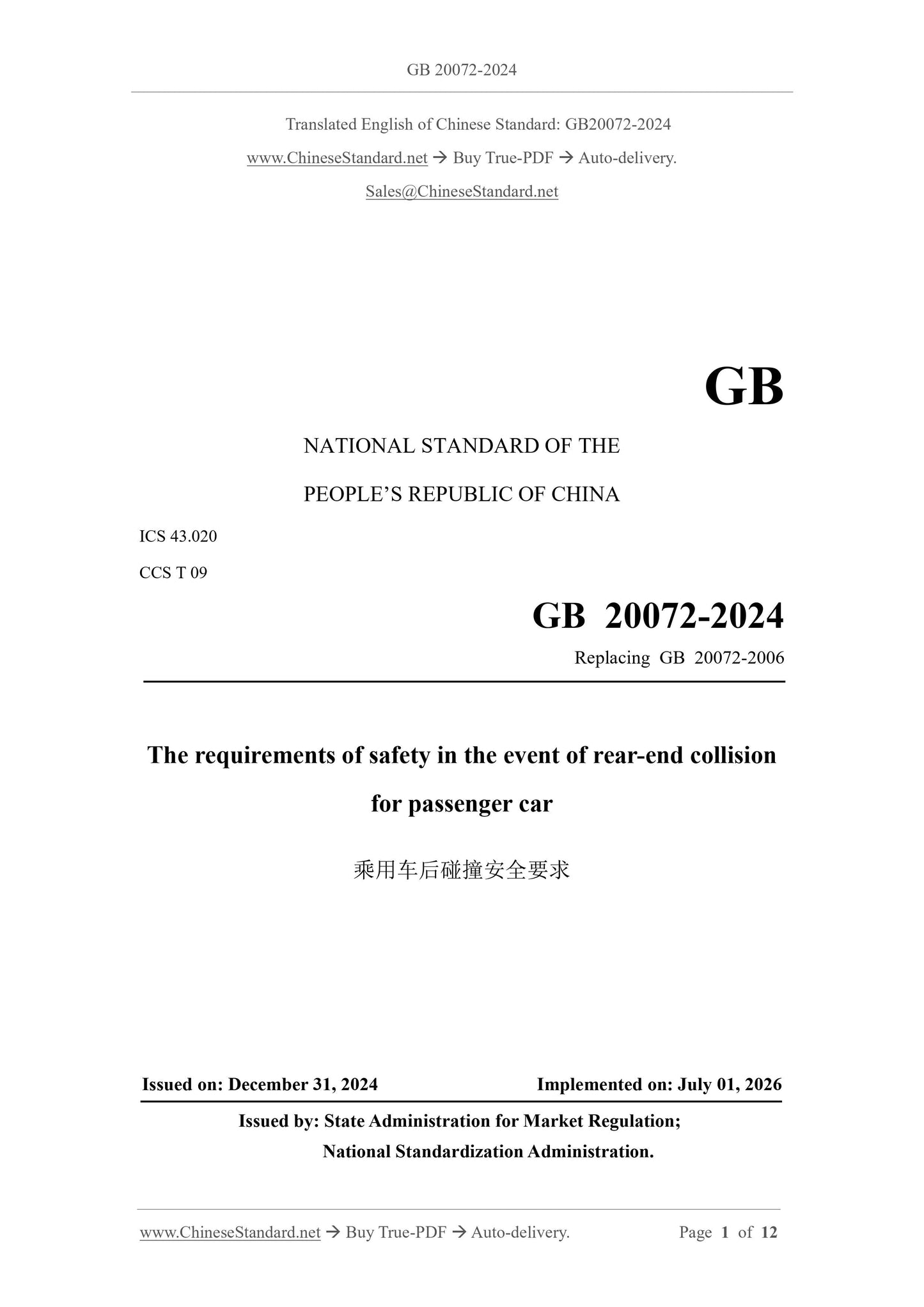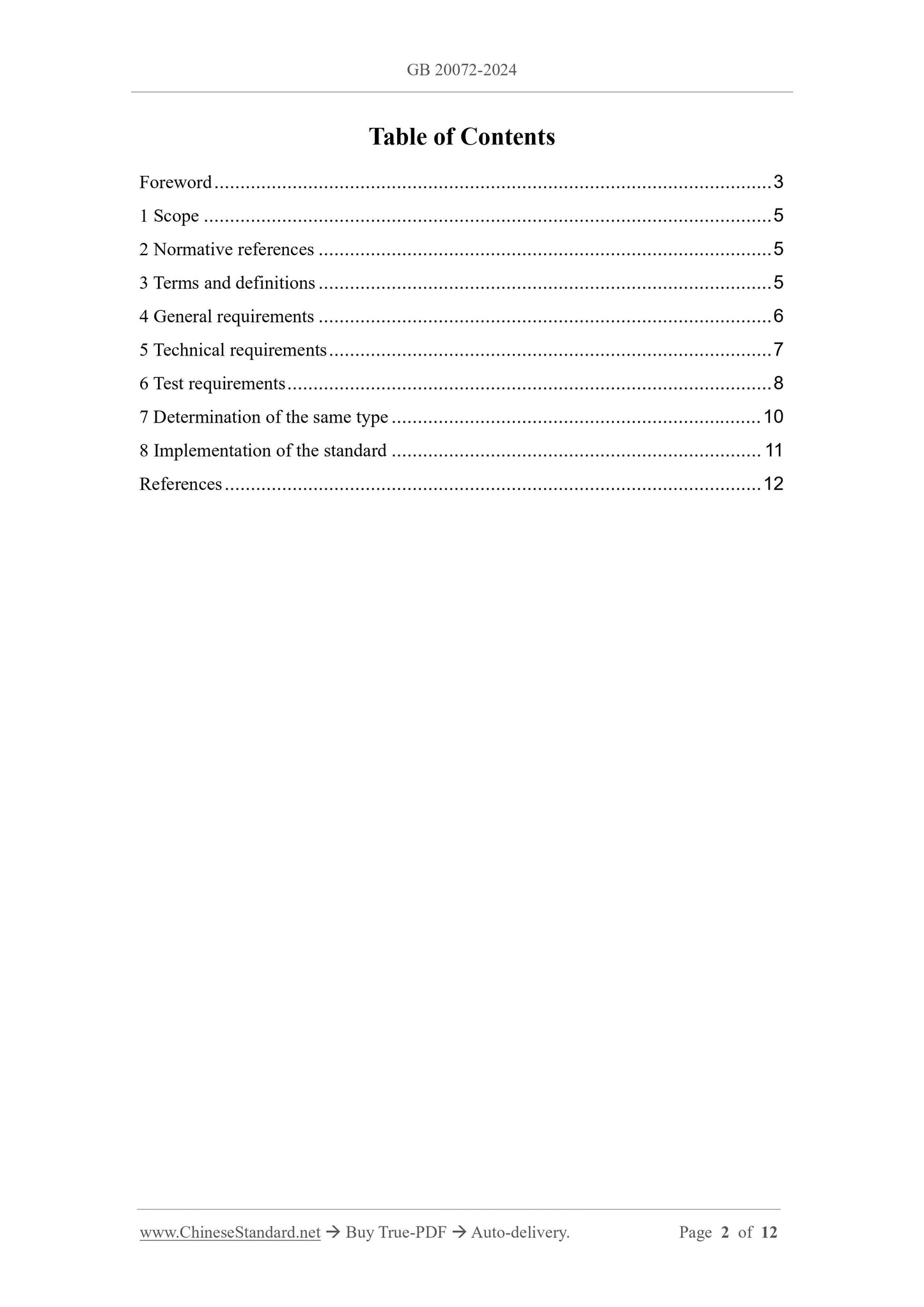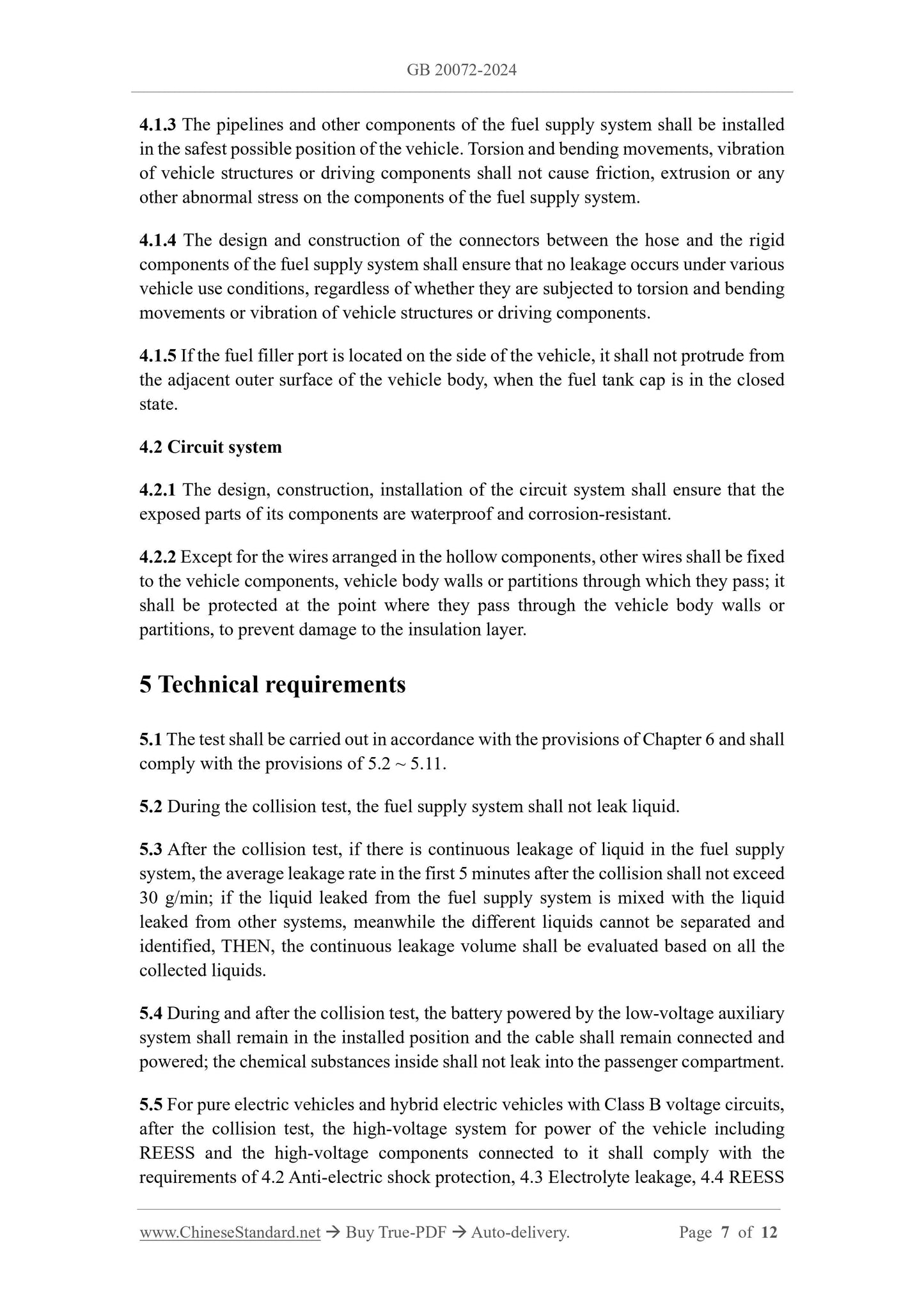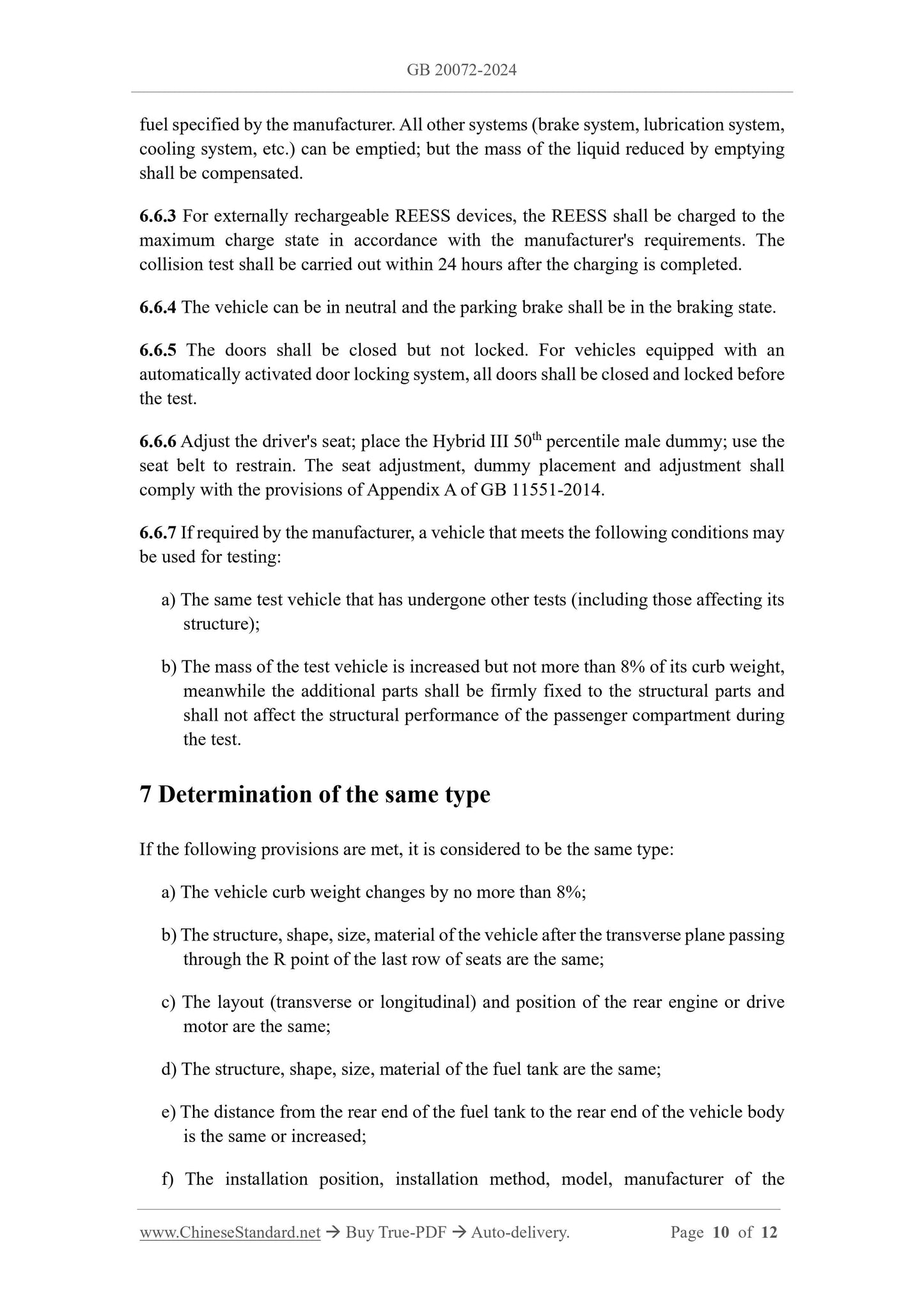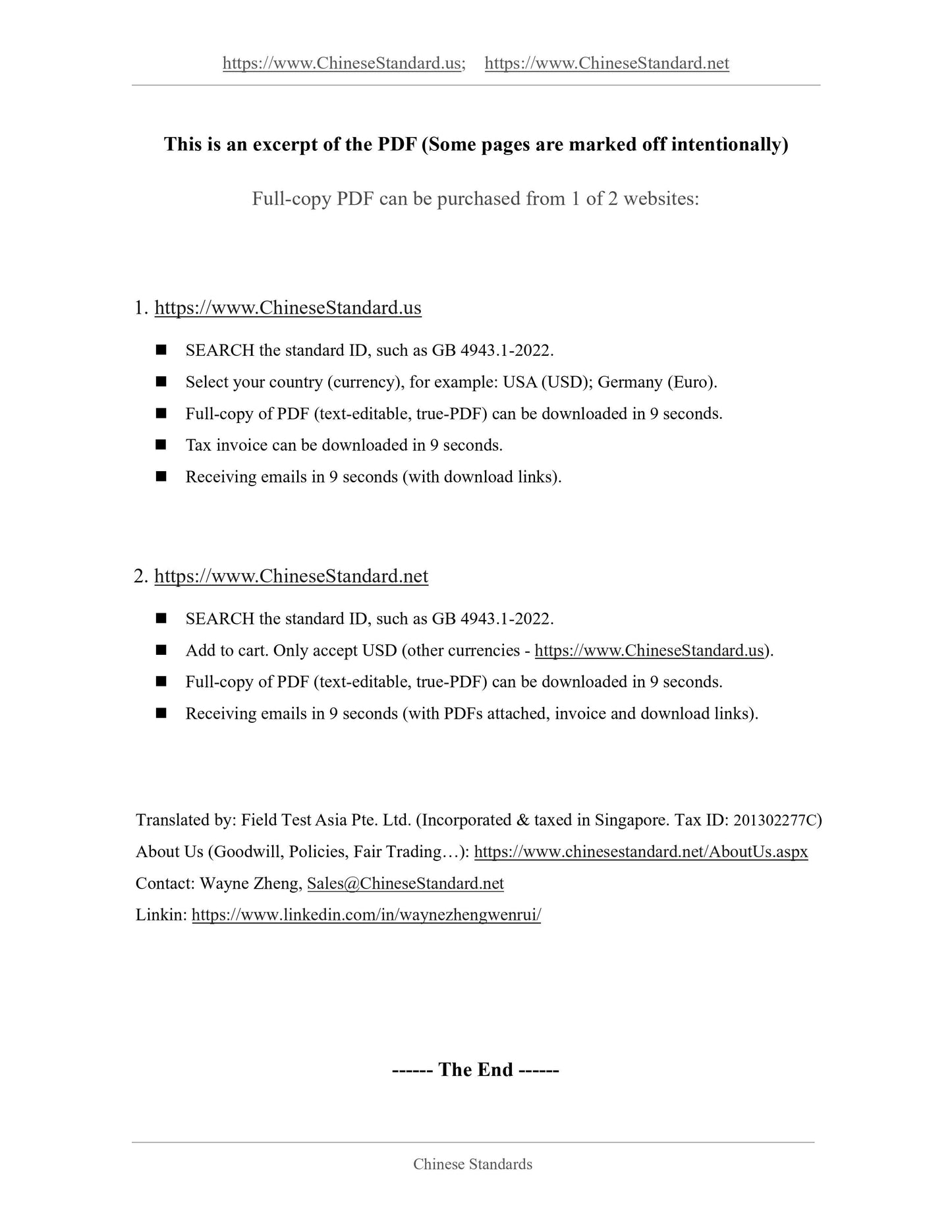1
/
of
7
www.ChineseStandard.us -- Field Test Asia Pte. Ltd.
GB 20072-2024 English PDF
GB 20072-2024 English PDF
Regular price
$185.00
Regular price
Sale price
$185.00
Unit price
/
per
Shipping calculated at checkout.
Couldn't load pickup availability
GB 20072-2024: The requirements of safety in the event of rear-end collision for passenger car
Delivery: 9 seconds. Download (& Email) true-PDF + Invoice.
Get Quotation: Click GB 20072-2024 (Self-service in 1-minute)
Historical versions (Master-website): GB 20072-2024
Preview True-PDF (Reload/Scroll-down if blank)
GB 20072-2024
GB
NATIONAL STANDARD OF THE
PEOPLE’S REPUBLIC OF CHINA
ICS 43.020
CCS T 09
Replacing GB 20072-2006
The requirements of safety in the event of rear-end collision
for passenger car
ISSUED ON. DECEMBER 31, 2024
IMPLEMENTED ON. JULY 01, 2026
Issued by. State Administration for Market Regulation;
National Standardization Administration.
Table of Contents
Foreword... 3
1 Scope... 5
2 Normative references... 5
3 Terms and definitions... 5
4 General requirements... 6
5 Technical requirements... 7
6 Test requirements... 8
7 Determination of the same type... 10
8 Implementation of the standard... 11
References... 12
The requirements of safety in the event of rear-end collision
for passenger car
1 Scope
This document specifies the general requirements, technical requirements, test
requirements for rear collision of passenger cars; provides the same type judgment rules.
This document applies to category M1 vehicles.
2 Normative references
The contents of the following documents constitute the essential terms of this document
through normative references in the text. Among them, for dated references, only the
version corresponding to the date applies to this document; for undated references, the
latest version (including all amendments) applies to this document.
GB 11551-2014 The protection of the occupants in the event of a frontal collision
for motor vehicle
GB 18296 Safety property requirements and test methods for automobile fuel tank
and its installation
GB/T 31498-2021 Post crash safety requirement for electric vehicle
3 Terms and definitions
The following terms and definitions apply to this document.
3.1
Passenger compartment
The space for accommodating passengers as surrounded by the roof, floor, side
panels, doors, glass windows, front panels, rear panels or rear seat back support
panels, as well as electrical protection barriers and shells to prevent passengers from
contacting live parts.
[Source. GB/T 19596-2017, 3.1.2.2.5]
3.2
4.1.3 The pipelines and other components of the fuel supply system shall be installed
in the safest possible position of the vehicle. Torsion and bending movements, vibration
of vehicle structures or driving components shall not cause friction, extrusion or any
other abnormal stress on the components of the fuel supply system.
4.1.4 The design and construction of the connectors between the hose and the rigid
components of the fuel supply system shall ensure that no leakage occurs under various
vehicle use conditions, regardless of whether they are subjected to torsion and bending
movements or vibration of vehicle structures or driving components.
4.1.5 If the fuel filler port is located on the side of the vehicle, it shall not protrude from
the adjacent outer surface of the vehicle body, when the fuel tank cap is in the closed
state.
4.2 Circuit system
4.2.1 The design, construction, installation of the circuit system shall ensure that the
exposed parts of its components are waterproof and corrosion-resistant.
4.2.2 Except for the wires arranged in the hollow components, other wires shall be fixed
to the vehicle components, vehicle body walls or partitions through which they pass; it
shall be protected at the point where they pass through the vehicle body walls or
partitions, to prevent damage to the insulation layer.
5 Technical requirements
5.1 The test shall be carried out in accordance with the provisions of Chapter 6 and shall
comply with the provisions of 5.2 ~ 5.11.
5.2 During the collision test, the fuel supply system shall not leak liquid.
5.3 After the collision test, if there is continuous leakage of liquid in the fuel supply
system, the average leakage rate in the first 5 minutes after the collision shall not exceed
30 g/min; if the liquid leaked from the fuel supply system is mixed with the liquid
leaked from other systems, meanwhile the different liquids cannot be separated and
identified, THEN, the continuous leakage volume shall be evaluated based on all the
collected liquids.
5.4 During and after the collision test, the battery powered by the low-voltage auxiliary
system shall remain in the installed position and the cable shall remain connected and
powered; the chemical substances inside shall not leak into the passenger compartment.
5.5 For pure electric vehicles and hybrid electric vehicles with Class B voltage circuits,
after the collision test, the high-voltage system for power of the vehicle including
REESS and the high-voltage components connected to it shall comply with the
requirements of 4.2 Anti-electric shock protection, 4.3 Electrolyte leakage, 4.4 REESS
in GB/T 31498-2021.
5.6 During the collision test, the doors (excluding the back door or tailgate) shall not be
opened.
5.7 After the collision test, the doors shall be unlocked. If the vehicle is equipped with
an automatically activated door locking system, the doors shall be locked before the
collision and unlocked after the test.
5.8 After the collision test, for each row of seats, at least one door (if any) shall be able
to be opened from the outside without the use of tools, to allow passengers to enter and
exit normally; if there are no doors, all passengers shall be able to evacuate without
using tools to move the seats or change the position of the seat backrest.
5.9 After the collision test, all internal components of the passenger compartment shall
not have sharp protrusions or jagged edges; the seats shall not separate from the body
structure; the adjustment and locking devices shall not fail; the internal components of
the passenger compartment are allowed to fall off due to permanent deformation
without increasing the risk of injury to the passengers.
5.10 During the collision test and within 30 minutes after the collision test, the vehicle
shall not catch fire (the phenomenon of continuous flames).
5.11 After the collision test, the vehicle shall automatically turn on the hazard warning
lights.
6 Test requirements
6.1 Test site
The test site shall be large enough, to accommodate the collision device drive system,
the movement of the impacted vehicle after the collision, the installation of the test
equipment. The site where the vehicle collides and moves shall be horizontal and flat;
the road friction coefficient shall not be less than 0.5.
6.2 Collision device
6.2.1 The collision device shall be a rigid steel structure.
6.2.2 The surface of the collision device shall be flat, with a width of not less than 2500
mm and a height of not less than 800 mm, an edge radius of 40 mm ~ 50 mm, which is
equipped a plywood with a thickness of 20 mm ± 1 mm on the surface.
6.2.3 The following requirements shall be met during collision.
a) The surface of the collision device is vertical and perpendicular to the longitudinal
center plane of the impacted vehicle;
fuel specified by the manufacturer. All other systems (brake system, lubrication system,
cooling system, etc.) can be emptied; but the mass of the liquid reduced by emptying
shall be compensated.
6.6.3 For externally rechargeable REESS devices, the REESS shall be charged to the
maximum charge state in accordance with the manufacturer's requirements. The
collision test shall be carried out within 24 hours after the charging is completed.
6.6.4 The vehicle can be in neutral and the parking brake shall be in the braking state.
6.6.5 The doors shall be closed but not locked. For vehicles equipped with an
automatically activated door locking system, all doors shall be closed and locked before
the test.
6.6.6 Adjust the driver's seat; place the Hybrid III 50th percentile male dummy; use the
seat belt to restrain. The seat adjustment, dummy placement and adjustment shall
comply with the provisions of Appendix A of GB 11551-2014.
6.6.7 If required by the manufacturer, a vehicle that meets the following conditions may
be used for testing.
a) The same test vehicle that has undergone other tests (including those affecting its
structure);
b) The mass of the test vehicle is increased but not more than 8% of its curb weight,
meanwhile the additional parts shall be firmly fixed to the structural parts and
shall not affect the structural performance of the passenger compartment during
the test.
7 Determination of the same type
If the following provisions are met, it is considered to be the same type.
a) The vehicle curb weight changes by no more than 8%;
b) The structure, shape, size, material of the vehicle after the transverse plane passing
through the R point of the last row of seats are the same;
c) The layout (transverse or longitudinal) and position of the rear engine or drive
motor are the same;
d) The structure, shape, size, material of the fuel tank are the same;
e) The distance from the rear end of the fuel tank to the rear end of the vehicle body
is the same or increased;
f) The installation position, installation method, model, manufacturer of the
GB 20072-2024
GB
NATIONAL STANDARD OF THE
PEOPLE’S REPUBLIC OF CHINA
ICS 43.020
CCS T 09
Replacing GB 20072-2006
The requirements of safety in the event of rear-end collision
for passenger car
ISSUED ON. DECEMBER 31, 2024
IMPLEMENTED ON. JULY 01, 2026
Issued by. State Administration for Market Regulation;
National Standardization Administration.
Table of Contents
Foreword... 3
1 Scope... 5
2 Normative references... 5
3 Terms and definitions... 5
4 General requirements... 6
5 Technical requirements... 7
6 Test requirements... 8
7 Determination of the same type... 10
8 Implementation of the standard... 11
References... 12
The requirements of safety in the event of rear-end collision
for passenger car
1 Scope
This document specifies the general requirements, technical requirements, test
requirements for rear collision of passenger cars; provides the same type judgment rules.
This document applies to category M1 vehicles.
2 Normative references
The contents of the following documents constitute the essential terms of this document
through normative references in the text. Among them, for dated references, only the
version corresponding to the date applies to this document; for undated references, the
latest version (including all amendments) applies to this document.
GB 11551-2014 The protection of the occupants in the event of a frontal collision
for motor vehicle
GB 18296 Safety property requirements and test methods for automobile fuel tank
and its installation
GB/T 31498-2021 Post crash safety requirement for electric vehicle
3 Terms and definitions
The following terms and definitions apply to this document.
3.1
Passenger compartment
The space for accommodating passengers as surrounded by the roof, floor, side
panels, doors, glass windows, front panels, rear panels or rear seat back support
panels, as well as electrical protection barriers and shells to prevent passengers from
contacting live parts.
[Source. GB/T 19596-2017, 3.1.2.2.5]
3.2
4.1.3 The pipelines and other components of the fuel supply system shall be installed
in the safest possible position of the vehicle. Torsion and bending movements, vibration
of vehicle structures or driving components shall not cause friction, extrusion or any
other abnormal stress on the components of the fuel supply system.
4.1.4 The design and construction of the connectors between the hose and the rigid
components of the fuel supply system shall ensure that no leakage occurs under various
vehicle use conditions, regardless of whether they are subjected to torsion and bending
movements or vibration of vehicle structures or driving components.
4.1.5 If the fuel filler port is located on the side of the vehicle, it shall not protrude from
the adjacent outer surface of the vehicle body, when the fuel tank cap is in the closed
state.
4.2 Circuit system
4.2.1 The design, construction, installation of the circuit system shall ensure that the
exposed parts of its components are waterproof and corrosion-resistant.
4.2.2 Except for the wires arranged in the hollow components, other wires shall be fixed
to the vehicle components, vehicle body walls or partitions through which they pass; it
shall be protected at the point where they pass through the vehicle body walls or
partitions, to prevent damage to the insulation layer.
5 Technical requirements
5.1 The test shall be carried out in accordance with the provisions of Chapter 6 and shall
comply with the provisions of 5.2 ~ 5.11.
5.2 During the collision test, the fuel supply system shall not leak liquid.
5.3 After the collision test, if there is continuous leakage of liquid in the fuel supply
system, the average leakage rate in the first 5 minutes after the collision shall not exceed
30 g/min; if the liquid leaked from the fuel supply system is mixed with the liquid
leaked from other systems, meanwhile the different liquids cannot be separated and
identified, THEN, the continuous leakage volume shall be evaluated based on all the
collected liquids.
5.4 During and after the collision test, the battery powered by the low-voltage auxiliary
system shall remain in the installed position and the cable shall remain connected and
powered; the chemical substances inside shall not leak into the passenger compartment.
5.5 For pure electric vehicles and hybrid electric vehicles with Class B voltage circuits,
after the collision test, the high-voltage system for power of the vehicle including
REESS and the high-voltage components connected to it shall comply with the
requirements of 4.2 Anti-electric shock protection, 4.3 Electrolyte leakage, 4.4 REESS
in GB/T 31498-2021.
5.6 During the collision test, the doors (excluding the back door or tailgate) shall not be
opened.
5.7 After the collision test, the doors shall be unlocked. If the vehicle is equipped with
an automatically activated door locking system, the doors shall be locked before the
collision and u...
Delivery: 9 seconds. Download (& Email) true-PDF + Invoice.
Get Quotation: Click GB 20072-2024 (Self-service in 1-minute)
Historical versions (Master-website): GB 20072-2024
Preview True-PDF (Reload/Scroll-down if blank)
GB 20072-2024
GB
NATIONAL STANDARD OF THE
PEOPLE’S REPUBLIC OF CHINA
ICS 43.020
CCS T 09
Replacing GB 20072-2006
The requirements of safety in the event of rear-end collision
for passenger car
ISSUED ON. DECEMBER 31, 2024
IMPLEMENTED ON. JULY 01, 2026
Issued by. State Administration for Market Regulation;
National Standardization Administration.
Table of Contents
Foreword... 3
1 Scope... 5
2 Normative references... 5
3 Terms and definitions... 5
4 General requirements... 6
5 Technical requirements... 7
6 Test requirements... 8
7 Determination of the same type... 10
8 Implementation of the standard... 11
References... 12
The requirements of safety in the event of rear-end collision
for passenger car
1 Scope
This document specifies the general requirements, technical requirements, test
requirements for rear collision of passenger cars; provides the same type judgment rules.
This document applies to category M1 vehicles.
2 Normative references
The contents of the following documents constitute the essential terms of this document
through normative references in the text. Among them, for dated references, only the
version corresponding to the date applies to this document; for undated references, the
latest version (including all amendments) applies to this document.
GB 11551-2014 The protection of the occupants in the event of a frontal collision
for motor vehicle
GB 18296 Safety property requirements and test methods for automobile fuel tank
and its installation
GB/T 31498-2021 Post crash safety requirement for electric vehicle
3 Terms and definitions
The following terms and definitions apply to this document.
3.1
Passenger compartment
The space for accommodating passengers as surrounded by the roof, floor, side
panels, doors, glass windows, front panels, rear panels or rear seat back support
panels, as well as electrical protection barriers and shells to prevent passengers from
contacting live parts.
[Source. GB/T 19596-2017, 3.1.2.2.5]
3.2
4.1.3 The pipelines and other components of the fuel supply system shall be installed
in the safest possible position of the vehicle. Torsion and bending movements, vibration
of vehicle structures or driving components shall not cause friction, extrusion or any
other abnormal stress on the components of the fuel supply system.
4.1.4 The design and construction of the connectors between the hose and the rigid
components of the fuel supply system shall ensure that no leakage occurs under various
vehicle use conditions, regardless of whether they are subjected to torsion and bending
movements or vibration of vehicle structures or driving components.
4.1.5 If the fuel filler port is located on the side of the vehicle, it shall not protrude from
the adjacent outer surface of the vehicle body, when the fuel tank cap is in the closed
state.
4.2 Circuit system
4.2.1 The design, construction, installation of the circuit system shall ensure that the
exposed parts of its components are waterproof and corrosion-resistant.
4.2.2 Except for the wires arranged in the hollow components, other wires shall be fixed
to the vehicle components, vehicle body walls or partitions through which they pass; it
shall be protected at the point where they pass through the vehicle body walls or
partitions, to prevent damage to the insulation layer.
5 Technical requirements
5.1 The test shall be carried out in accordance with the provisions of Chapter 6 and shall
comply with the provisions of 5.2 ~ 5.11.
5.2 During the collision test, the fuel supply system shall not leak liquid.
5.3 After the collision test, if there is continuous leakage of liquid in the fuel supply
system, the average leakage rate in the first 5 minutes after the collision shall not exceed
30 g/min; if the liquid leaked from the fuel supply system is mixed with the liquid
leaked from other systems, meanwhile the different liquids cannot be separated and
identified, THEN, the continuous leakage volume shall be evaluated based on all the
collected liquids.
5.4 During and after the collision test, the battery powered by the low-voltage auxiliary
system shall remain in the installed position and the cable shall remain connected and
powered; the chemical substances inside shall not leak into the passenger compartment.
5.5 For pure electric vehicles and hybrid electric vehicles with Class B voltage circuits,
after the collision test, the high-voltage system for power of the vehicle including
REESS and the high-voltage components connected to it shall comply with the
requirements of 4.2 Anti-electric shock protection, 4.3 Electrolyte leakage, 4.4 REESS
in GB/T 31498-2021.
5.6 During the collision test, the doors (excluding the back door or tailgate) shall not be
opened.
5.7 After the collision test, the doors shall be unlocked. If the vehicle is equipped with
an automatically activated door locking system, the doors shall be locked before the
collision and unlocked after the test.
5.8 After the collision test, for each row of seats, at least one door (if any) shall be able
to be opened from the outside without the use of tools, to allow passengers to enter and
exit normally; if there are no doors, all passengers shall be able to evacuate without
using tools to move the seats or change the position of the seat backrest.
5.9 After the collision test, all internal components of the passenger compartment shall
not have sharp protrusions or jagged edges; the seats shall not separate from the body
structure; the adjustment and locking devices shall not fail; the internal components of
the passenger compartment are allowed to fall off due to permanent deformation
without increasing the risk of injury to the passengers.
5.10 During the collision test and within 30 minutes after the collision test, the vehicle
shall not catch fire (the phenomenon of continuous flames).
5.11 After the collision test, the vehicle shall automatically turn on the hazard warning
lights.
6 Test requirements
6.1 Test site
The test site shall be large enough, to accommodate the collision device drive system,
the movement of the impacted vehicle after the collision, the installation of the test
equipment. The site where the vehicle collides and moves shall be horizontal and flat;
the road friction coefficient shall not be less than 0.5.
6.2 Collision device
6.2.1 The collision device shall be a rigid steel structure.
6.2.2 The surface of the collision device shall be flat, with a width of not less than 2500
mm and a height of not less than 800 mm, an edge radius of 40 mm ~ 50 mm, which is
equipped a plywood with a thickness of 20 mm ± 1 mm on the surface.
6.2.3 The following requirements shall be met during collision.
a) The surface of the collision device is vertical and perpendicular to the longitudinal
center plane of the impacted vehicle;
fuel specified by the manufacturer. All other systems (brake system, lubrication system,
cooling system, etc.) can be emptied; but the mass of the liquid reduced by emptying
shall be compensated.
6.6.3 For externally rechargeable REESS devices, the REESS shall be charged to the
maximum charge state in accordance with the manufacturer's requirements. The
collision test shall be carried out within 24 hours after the charging is completed.
6.6.4 The vehicle can be in neutral and the parking brake shall be in the braking state.
6.6.5 The doors shall be closed but not locked. For vehicles equipped with an
automatically activated door locking system, all doors shall be closed and locked before
the test.
6.6.6 Adjust the driver's seat; place the Hybrid III 50th percentile male dummy; use the
seat belt to restrain. The seat adjustment, dummy placement and adjustment shall
comply with the provisions of Appendix A of GB 11551-2014.
6.6.7 If required by the manufacturer, a vehicle that meets the following conditions may
be used for testing.
a) The same test vehicle that has undergone other tests (including those affecting its
structure);
b) The mass of the test vehicle is increased but not more than 8% of its curb weight,
meanwhile the additional parts shall be firmly fixed to the structural parts and
shall not affect the structural performance of the passenger compartment during
the test.
7 Determination of the same type
If the following provisions are met, it is considered to be the same type.
a) The vehicle curb weight changes by no more than 8%;
b) The structure, shape, size, material of the vehicle after the transverse plane passing
through the R point of the last row of seats are the same;
c) The layout (transverse or longitudinal) and position of the rear engine or drive
motor are the same;
d) The structure, shape, size, material of the fuel tank are the same;
e) The distance from the rear end of the fuel tank to the rear end of the vehicle body
is the same or increased;
f) The installation position, installation method, model, manufacturer of the
GB 20072-2024
GB
NATIONAL STANDARD OF THE
PEOPLE’S REPUBLIC OF CHINA
ICS 43.020
CCS T 09
Replacing GB 20072-2006
The requirements of safety in the event of rear-end collision
for passenger car
ISSUED ON. DECEMBER 31, 2024
IMPLEMENTED ON. JULY 01, 2026
Issued by. State Administration for Market Regulation;
National Standardization Administration.
Table of Contents
Foreword... 3
1 Scope... 5
2 Normative references... 5
3 Terms and definitions... 5
4 General requirements... 6
5 Technical requirements... 7
6 Test requirements... 8
7 Determination of the same type... 10
8 Implementation of the standard... 11
References... 12
The requirements of safety in the event of rear-end collision
for passenger car
1 Scope
This document specifies the general requirements, technical requirements, test
requirements for rear collision of passenger cars; provides the same type judgment rules.
This document applies to category M1 vehicles.
2 Normative references
The contents of the following documents constitute the essential terms of this document
through normative references in the text. Among them, for dated references, only the
version corresponding to the date applies to this document; for undated references, the
latest version (including all amendments) applies to this document.
GB 11551-2014 The protection of the occupants in the event of a frontal collision
for motor vehicle
GB 18296 Safety property requirements and test methods for automobile fuel tank
and its installation
GB/T 31498-2021 Post crash safety requirement for electric vehicle
3 Terms and definitions
The following terms and definitions apply to this document.
3.1
Passenger compartment
The space for accommodating passengers as surrounded by the roof, floor, side
panels, doors, glass windows, front panels, rear panels or rear seat back support
panels, as well as electrical protection barriers and shells to prevent passengers from
contacting live parts.
[Source. GB/T 19596-2017, 3.1.2.2.5]
3.2
4.1.3 The pipelines and other components of the fuel supply system shall be installed
in the safest possible position of the vehicle. Torsion and bending movements, vibration
of vehicle structures or driving components shall not cause friction, extrusion or any
other abnormal stress on the components of the fuel supply system.
4.1.4 The design and construction of the connectors between the hose and the rigid
components of the fuel supply system shall ensure that no leakage occurs under various
vehicle use conditions, regardless of whether they are subjected to torsion and bending
movements or vibration of vehicle structures or driving components.
4.1.5 If the fuel filler port is located on the side of the vehicle, it shall not protrude from
the adjacent outer surface of the vehicle body, when the fuel tank cap is in the closed
state.
4.2 Circuit system
4.2.1 The design, construction, installation of the circuit system shall ensure that the
exposed parts of its components are waterproof and corrosion-resistant.
4.2.2 Except for the wires arranged in the hollow components, other wires shall be fixed
to the vehicle components, vehicle body walls or partitions through which they pass; it
shall be protected at the point where they pass through the vehicle body walls or
partitions, to prevent damage to the insulation layer.
5 Technical requirements
5.1 The test shall be carried out in accordance with the provisions of Chapter 6 and shall
comply with the provisions of 5.2 ~ 5.11.
5.2 During the collision test, the fuel supply system shall not leak liquid.
5.3 After the collision test, if there is continuous leakage of liquid in the fuel supply
system, the average leakage rate in the first 5 minutes after the collision shall not exceed
30 g/min; if the liquid leaked from the fuel supply system is mixed with the liquid
leaked from other systems, meanwhile the different liquids cannot be separated and
identified, THEN, the continuous leakage volume shall be evaluated based on all the
collected liquids.
5.4 During and after the collision test, the battery powered by the low-voltage auxiliary
system shall remain in the installed position and the cable shall remain connected and
powered; the chemical substances inside shall not leak into the passenger compartment.
5.5 For pure electric vehicles and hybrid electric vehicles with Class B voltage circuits,
after the collision test, the high-voltage system for power of the vehicle including
REESS and the high-voltage components connected to it shall comply with the
requirements of 4.2 Anti-electric shock protection, 4.3 Electrolyte leakage, 4.4 REESS
in GB/T 31498-2021.
5.6 During the collision test, the doors (excluding the back door or tailgate) shall not be
opened.
5.7 After the collision test, the doors shall be unlocked. If the vehicle is equipped with
an automatically activated door locking system, the doors shall be locked before the
collision and u...
Share
